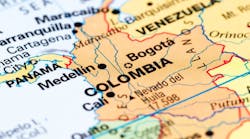A/S Norske Shell has drilled a potentially large gas discovery in the Norwegian Sea in the deepest water of any find there, said the Norwegian Petroleum Directorate.
The 6603/12-1 well on the Gro prospect in 1,376 m of water cut a 16-m gas column in a reservoir of varying quality of Upper Cretaceous age.
In light of the variations in reservoir quality, the NPD estimated the range of recoverable gas at between 353 bcf and 3.5 tcf. The well was not formation tested, but the operator performed extensive sampling and data acquisition.
“Further delineation drilling is needed in order to clarify the resource potential, including the possibility of additional volumes,” the NPD said, and may indicate a petroleum system that extends farther to the west where no drilling has taken place.
TD is 3,805 m true vertical depth in Upper Cretaceous, probably the Springar formation. The well is the first exploration test in Petroleum License 326.
Gro is 150 km northwest of the 6506/6-1 Victoria discovery well drilled by Mobil Exploration Norway in 2000 and thought to be the largest undeveloped gas discovery on the Norwegian shelf. Bottomhole temperature at Victoria is 200° C., NPD said.
Victoria, a high-pressure, high-temperature Jurassic gas find in 420 m of water 200 km offshore, is now operated by Total with 50% interest. Statoil- Hydro Petroleum AS has 30%, and Eni Norge has 20%. Victoria is in PL 211.
Participants in Gro in PL 326 are Norske Shell 50%, StatoilHydro 40%, and GDF Suez E&P Norge AS 10%.


